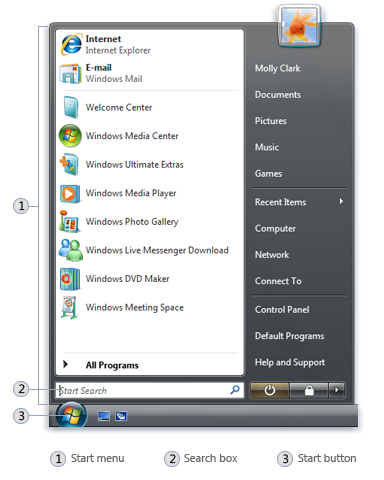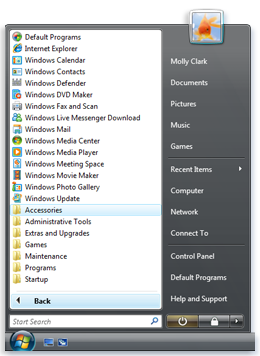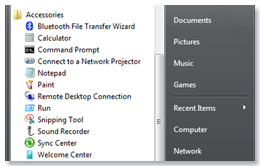Certify and Increase Opportunity.
Be
Govt. Certified Computer Fundamentals MS Office
The Start menu (overview)
The Start menu is the main gateway to your computer’s programs, folders, and settings. It’s called a menu because it provides a list of choices, just as a restaurant menu does. And as “Start” implies, it’s often the place that you’ll go to start or open things.
Use the Start menu to do these common activities:
- Start programs
- Open commonly used folders
- Search for files, folders, and programs
- Adjust computer settings
- Get help with the Windows operating system
- Turn off the computer
- Log off from Windows or switch to a different user account
Getting started with the Start menu
 in the lower-left corner of your screen. Or, press the Windows logo key
in the lower-left corner of your screen. Or, press the Windows logo key  on your keyboard. The Start menu appears.
on your keyboard. The Start menu appears. Start button and Start menu
Start button and Start menuThe Start menu is divided into three basic parts:
- The large left pane shows a short list of programs on your computer. Your computer manufacturer can customize this list, so its exact appearance will vary. Clicking All Programs displays a complete list of programs (more on this later).
- In the lower left corner is the search box, which allows you to look for programs and files on your computer by typing in search terms.
- The right pane provides access to commonly used folders, files, settings, and features. It’s also where you go to log off from Windows or turn off your computer.
Opening programs from the Start menu
One of the most common uses of the Start menu is opening programs installed on your computer. To open a program shown in the left pane of the Start menu, click it. The program opens and the Start menu closes.
If you don’t see the program you want to open, click All Programs at the bottom of the left pane. Instantly, the left pane displays a long list of programs in alphabetical order, followed by a list of folders:
 The Start menu after clicking All Programs
The Start menu after clicking All ProgramsClicking one of the program icons launches the program, and the Start menu closes. So what’s inside the folders? More programs. Click Accessories, for example, and a list of programs that are stored in that folder appears. Click any program to open it. To get back to the programs you saw when you first opened the Start menu, click Back near the bottom of the menu.
 Clicking the Accessories folder shows the programs it contains
Clicking the Accessories folder shows the programs it containsIf you’re ever unsure what a program does, move the pointer over its icon or name. A box appears that often contains a description of the program. For example, pointing to Calculator displays this message: “Performs basic arithmetic tasks with an on-screen calculator.” This trick works for items in the right pane of the Start menu, too.
 Pointing to an item displays information about it
Pointing to an item displays information about itYou might notice that over time, the lists of programs in your Start menu change. This happens for two reasons. First, when you install new programs, they get added to the All Programs list. Second, the Start menu detects which programs you use the most, and it places them in the left pane for quick access.
The Search box
The Search box is one of the most convenient ways to find things on your computer. The exact location of the items doesn’t matter—the Search box will scour your programs and all of the folders in your personal folder (which includes Documents, Pictures, Music, Desktop, and other common locations). It will also search your e-mail messages, saved instant messages, appointments, and contacts.
 The Start menu Search box
The Start menu Search boxTo use the Search box, open the Start menu and start typing. You don’t need to click inside the box first. As you type, the search results appear above the Search box in the left pane of the Start menu.
A program, file, or folder will appear as a search result if:
- Any word in its title matches or begins with your search term.
- Any text in the actual contents of the file—such as the text in a word-processing document—matches or begins with your search term.
- Any word in a property of the file, such as the author, matches or begins with your search term.
Besides programs, files and folders, and communications, the Search box also looks through your Internet favorites and the history of websites you’ve visited. If any of these webpages include the search term, they appear under a heading called “Favorites and History.”
What’s in the right pane?
The right pane of the Start menu contains links to parts of Windows that you’re likely to use frequently. Here they are, from top to bottom:
- Personal folder. Opens your personal folder, which is named for whoever is currently logged on to Windows. For example, if the current user is Molly Clark, the folder will be named Molly Clark. This folder, in turn, contains user-specific files, including the Documents, Music, Pictures, and Videos folders.
- Documents. Opens the Documents folder, where you can store and open text files, spreadsheets, presentations, and other kinds of documents.
- Pictures. Opens the Pictures folder, where you can store and view digital pictures and graphics files.
- Music. Opens the Music folder, where you can store and play music and other audio files.
- Games. Opens the Games folder, where you can access all of the games on your computer.
- Recent Items. Opens a list of files you’ve opened recently. Click one of the files in the list to open it.
- Computer. Opens a window where you can access disk drives, cameras, printers, scanners, and other hardware connected to your computer.
- Network. Opens a window where you can access the computers and devices on your network.
- Connect To. Opens a window where you can connect to a new network.
- Control Panel. Opens Control Panel, where you can customize the appearance and functionality of your computer, add or remove programs, set up network connections, and manage user accounts.
- Default Programs. Opens a window where you can choose which program you want Windows to use for activities like web browsing, editing pictures, sending e-mail, and playing music and videos.
- Help and Support. Opens Windows Help and Support, where you can browse and search Help topics about using Windows and your computer.
At the bottom of the right pane are two buttons: the Power button and the Lock button. Click the Power button to turn off your computer, or click the Lock button to lock your computer without turning it off. Once locked, your computer cannot be used until you unlock it with your password.Clicking the arrow next to the lock button displays a menu with additional options for switching users, logging off, restarting, or shutting down.
Note
The Switch User option does not appear on the Start menu in Windows Vista Starter.
Customize the Start menu
You can control which items appear in the Start menu. For example, you can add icons for your favorite programs to the Start menu for easy access, or remove programs from the list. You can also choose to hide or display certain items in the right pane.
Apply for Computer Fundamentals Certification Now!!
http://www.vskills.in/certification/Certified-computer-fundamentals-ms-office-professional-vs-1021

